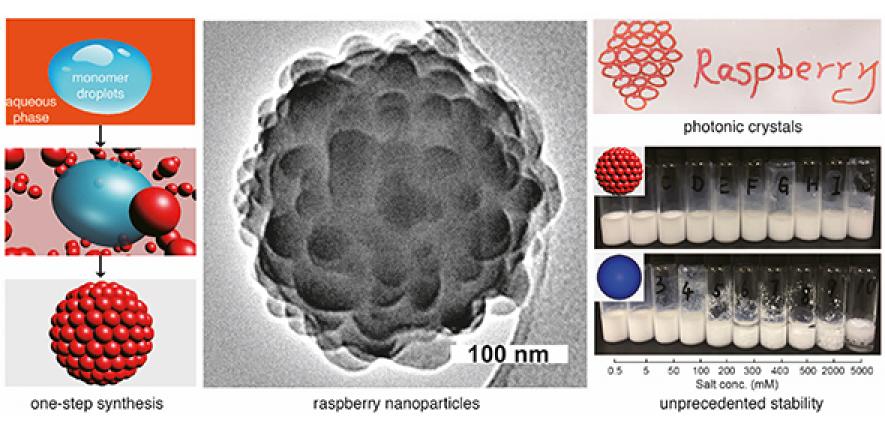
Colloids are microscopically small substances that spread out uniformly through another material and don’t settle to the bottom. When the material is a fluid, the result is a colloidal solution, dispersion or suspension.
Natural and artificial colloidal solutions are common in everyday life and include fog, hair sprays, paints, milk, hand lotion and jellies. These solutions are particularly important in the medical field, where they are often used in intravenous solutions to regulate blood conditions and other functions.
However, the applicability of colloidal solutions is limited by their stability in certain conditions. Scientists from the Melville Laboratory, working with Dr. Erika Eiser from the Cambridge Cavendish Laboratory, have now designed new colloids that remain stable in a variety of conditions, due to their raspberry-like shape.
In a paper published in Nature Communications, the team describes the synthesis of these new raspberry-like colloids, dubbed “raspberries.” They report that these raspberries show unexpected stability against aggregation over large variations of added salt concentrations and without the addition of stabilisers.
The colloids are synthesised in a single step, making the process more efficient and sustainable than traditional multi-step methods. The procedure involves injecting acrylate monomers, styrene and the cross-linker divinylbenzene into a water-ethanol solution and inducing simultaneous dispersion polymerisation of the ingredients. The resulting particles fuse to the final shape of the raspberry colloids in the presence of the cross-linker.
The researchers were surprised to find that the new raspberry colloid dispersions showed robust stability during the formation of superspheres, as well as unexpected stability against salting.
The team concluded that the stability of the colloids is due to their raspberry-like shape, which also allows for spontaneous self-assembly into hexagonally close-packed photonic crystals. These self-assembled lattice structures have a strong reflective factor making them appear brilliantly red under some angles. This suggests possible uses as ‘photonic ink’ for secure printing and responsive coatings.
Their unique architecture also makes the colloids excellent materials for superhydrophobic coatings, water purification and catalytic applications, say the authors, noting that other possible applications include use in sustainable paints, food products and drug delivery.
Unexpected stability of aqueous dispersions of raspberry-like colloids, Nature Communications 9, article number 3614 (2018), Yang Lan, Alessio Caciagli, Giulia Giudetti, Ziyi Yu, Ji Liu, Villads E. Johansen, Marlous Kamp, Chris Abell, Silvia Vignolini, Oren A. Scherman & Erika Eiser

